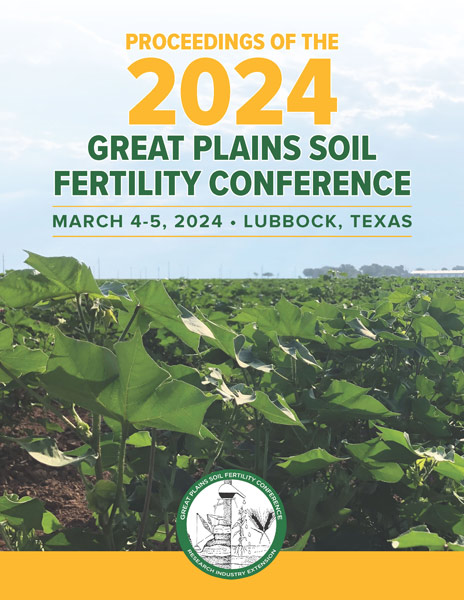Conference Proceedings Available!
Proceedings
Authors
| Filter results8 paper(s) found. |
|---|
1. Tillage and Nitrogen Management for Irrigated Sugarbeet Production in Eastern MontanaSugar beet (Beta vulgaris L.) is an important cash crop in the Lower Yellowstone River region. Nitrogen management is very critical while farmers are transitioning sugar beet production from conventional tillage to no-till system. The objectives of this study were to: (i) evaluate the effects of fertilizer-N rate and application timing on sugar beet root yield, sugar content, and quality under conventional and no-till managements, (ii) determine N uptake and N use efficiency (NUE)... A. Sutradhar, W. Franck, R. Garza, C. Chen |
2. Effects of Climate Change and Narrow Rows with Higher Plant Densities on Yields of Irrigated CornClimate change is significantly impacting agricultural systems worldwide, and although there are reports of these impacts contributing to higher yields in some regions, the general consensus is that there will be negative impacts on yields and soil quality across large regions. Management practices that can contribute to higher yields and adaptation to a changing climate will be important during the 21st century. This presentation will cover results from two manuscripts that are currently... J.A. Delgado, B. Floyd, R. D'adamo, A. Villacis, A.D. Brandt, A. Halvorson, C.E. Stewart, J. Alwang, S. Del grosso, D.K. Manter |
3. Legacy Impacts of Cattle Grazing on Soil N2O and CH4 Fluxes in Shortgrass SteppeGrazing cattle directly emit CH4 from enteric fermentation and contribute to soil N gas emissions related to nitrogen and organic matter additions from urine and manure deposits. Grazed soils can be sources or sinks of CH4, depending on moisture levels and localized manure patches. N2O emissions are related to availability of water as well as mineral N and labile C substrates in soil. Previously, we observed higher N2O and NH3 losses from fresh patches of urine and manure compared to... S. Del grosso, J. Derner, J. Delgado |
4. Soil Carbon and Agroecosystem Benefits of Conservation Management and Perennial Bioenergy Crop ProductionConservation agricultural management practices and perennial bioenergy crops can increase soil organic C (SOC) stocks on marginal soils yet the time necessary to observe these benefits, as well as the upper limit of C storage isn’t known. Co-benefits often associated with SOC accumulation are positive effects on water and nutrient retention, soil microbial biomass and diversity and soil structure, resulting in better soil quality. However, interactions between nitrogen fertilizer, crop biochemistry,... C.E. Stewart, V.L. Jin, M.R. Schmer, R.B. Mitchell, C. Williams, G.L. Miner |
5. Soil Microbes Are Critical to Maintaining Soil Fertility in the Great PlainsSoil in the Great Plains is known to be susceptible to wind and water erosion due to moisture deficits throughout the region that limit soil organic matter (SOM) accumulation that helps form stable soil structure. Conservation management practices like reduced tillage are emphasized to maintain SOM that provides habitat for soil microbes to perform ecosystem services related to nutrient cycling and soil aggregation to increase resistance to erosion and maintain fertile topsoil. Soils under long-term... W. Roper, V. Acosta-martinez, J. Moore, M. Mikha, D.K. Manter, C.E. Stewart, R.M. Lehman, M.A. Liebig, V.L. Jin |
6. Effect of Seeding Rate on Annual Warm Season Forage Yield and Plant StructureDue to the decline of the Ogallala Aquifer and reduced irrigation capacity, there is growing interest in more water-efficient cropping systems in the semi-arid central Great Plains. To support the region’s livestock industry, there is increased interest in forages because they use water more efficiently than grain crops. However, there is insufficient information on summer annual forage seeding rates in the range of environments encountered in the region. The objective of this study was... J. Holman, N. Detter, A. Obour, P. Tamea |
7. Summer Annual Legumes: Yield Potential and Water UseDue to the decline of the Ogalla Aquifer and reduced irrigation capacity, there is a growing interest in more water-efficient cropping systems in the semi-arid central Great Plains. One of the most water-intense crops grown on the semi-arid central Great Plains is alfalfa (Medicago sativa L.). Alfalfa is grown for its nutritive value and protein, which is highly desired by cow/calf, feed yards, and dairies of the central and southern Great Plains. The purpose of this study was to evaluate... J. Holman, N. Detter, A. Obour, L. Haag, K. Roozeboom |
8. Side-dress Applied ESN Reduces N2O Compared with Single Urea Application for Irrigated CornEnhanced efficiency fertilizer (poly coated urea, may reduce soil nitrous oxide (N2O) emissions while maintaining or increasing crop yields. However, further increases in N fertilizer efficiency may be attainable with a starter fertilizer application followed by side-dressed EEF. We monitored soil N2O using surface chambers from three N treatments [202 kg N ha-1 single application of urea, 34 kg N ha-1 starter urea combined with 168 kg N... S. Del grosso, J. Delgado, C.E. Stewart |
